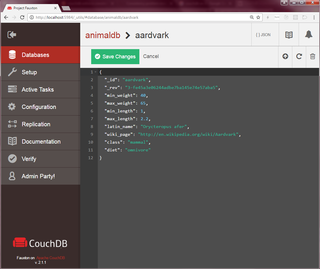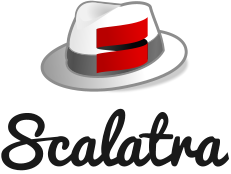
Ruby is an interpreted, high-level, general-purpose programming language. It was designed with an emphasis on programming productivity and simplicity. In Ruby, everything is an object, including primitive data types. It was developed in the mid-1990s by Yukihiro "Matz" Matsumoto in Japan.

Ruby on Rails is a server-side web application framework written in Ruby under the MIT License. Rails is a model–view–controller (MVC) framework, providing default structures for a database, a web service, and web pages. It encourages and facilitates the use of web standards such as JSON or XML for data transfer and HTML, CSS and JavaScript for user interfacing. In addition to MVC, Rails emphasizes the use of other well-known software engineering patterns and paradigms, including convention over configuration (CoC), don't repeat yourself (DRY), and the active record pattern.
JRuby is an implementation of the Ruby programming language atop the Java Virtual Machine, written largely in Java. It is free software released under a three-way EPL/GPL/LGPL license. JRuby is tightly integrated with Java to allow the embedding of the interpreter into any Java application with full two-way access between the Java and the Ruby code.

Capistrano is an open-source tool for running scripts on multiple servers; its main use is deploying web applications. It automates the process of making a new version of an application available on one or more web servers, including supporting tasks such as changing databases.
CherryPy is an object-oriented web application framework using the Python programming language. It is designed for rapid development of web applications by wrapping the HTTP protocol but stays at a low level and does not offer much more than what is defined in RFC 7231.

David Heinemeier Hansson, also known as DHH, is a Danish software engineer, programmer, writer, entrepreneur, and racing driver. He is the creator of Ruby on Rails, a web framework written in Ruby. He is also a partner and chief technology officer at the web-based software development firm 37signals.
WEBrick is a Ruby library providing simple HTTP web servers. It uses basic access authentication and digest access authentication for different kinds of servers that it can create - HTTP based server, HTTPS server, proxy server and virtual-host server. Construction of several non-HTTP servers such as the Day Time Server which uses the Daytime Protocol rather than the HTTP is also facilitated by WEBrick. It is used by the Ruby on Rails and Padrino frameworks to test applications in a development environment as well as production mode for small loads. It is now a part of Ruby standard library.

Jonathan Gillette, known by the pseudonym why the lucky stiff, is a writer, cartoonist, artist, and programmer notable for his work with the Ruby programming language. Annie Lowrey described him as "one of the most unusual, and beloved, computer programmers" in the world. Along with Yukihiro Matsumoto and David Heinemeier Hansson, he was seen as one of the key figures in the Ruby community. His pseudonym might allude to the exclamation "Why, the lucky stiff!" from The Fountainhead by Ayn Rand.
IronRuby is an implementation of the Ruby programming language targeting Microsoft .NET Framework. It is implemented on top of the Dynamic Language Runtime (DLR), a library running on top of the Common Language Infrastructure that provides dynamic typing and dynamic method dispatch, among other things, for dynamic languages.
MonoRail, a component of the Castle Project, is an open source web application framework built on top of the ASP.NET platform. Inspired by Ruby on Rails Action Pack, MonoRail differs from standard ASP.NET Web Forms development by enforcing separation of concerns using a model–view–controller (MVC) architecture. The framework is commonly used in conjunction with Castle ActiveRecord, an ORM layer built on NHibernate. In January 2010, version 2.0 of MonoRail was released, however, many projects use the trunk version of the source to take advantage of new features without waiting for official releases.

Richard Kilmer is a technology entrepreneur, software programmer and conference host and speaker in the open-source software community. He is an open-source contributor and developer of commercial software applications built in Ruby and Flash. His best known open-source software creation is of RubyGems, a package manager for the Ruby programming language most commonly used in downloads and deployments of the Ruby on Rails web application framework. He is currently the Co-Founder and CEO of CargoSense, Inc.

Apache CouchDB is an open-source document-oriented NoSQL database, implemented in Erlang.

Lift is a free and open-source web framework that is designed for the Scala programming language. It was originally created by David Pollak who was dissatisfied with certain aspects of the Ruby on Rails framework. Lift was launched as an open source project on 26 February 2007 under the Apache License 2.0. A commercially popular web platform often cited as being developed using Lift is Foursquare.
Heroku is a cloud platform as a service (PaaS) supporting several programming languages. As one of the first cloud platforms, Heroku has been in development since June 2007, when it supported only the Ruby programming language, but now also supports Java, Node.js, Scala, Clojure, Python, PHP, and Go. For this reason, Heroku is said to be a polyglot platform as it has features for a developer to build, run and scale applications in a similar manner across most of these languages. Heroku was acquired by Salesforce in 2010 for $212 million.

Rack is a modular interface between web servers and web applications developed in the Ruby programming language. With Rack, application programming interfaces (APIs) for web frameworks and middleware are wrapped into a single method call handling HTTP requests and responses.

Play Framework is an open-source web application framework which follows the model–view–controller (MVC) architectural pattern. It is written in Scala and usable from other programming languages that are compiled to JVM bytecode, e.g. Java. It aims to optimize developer productivity by using convention over configuration, hot code reloading and display of errors in the browser.
Mirah has been a programming language based on Ruby language syntax, local type inference, hybrid static–dynamic type system, and a pluggable compiler toolchain. Mirah was created by Charles Oliver Nutter to be "a 'Ruby-like' language, probably a subset of Ruby syntax, that [could] compile to solid, fast, idiomatic JVM bytecode." The word mirah refers to the gemstone ruby in the Javanese language, a play on the concept of Ruby in Java.

Dancer is an open source lightweight web application framework written in Perl and inspired by Ruby's Sinatra.

Scalatra is a free and open source web application framework written in Scala. It is a port of the Sinatra framework written in Ruby. Scalatra is an alternative to the Lift, Play!, and Unfiltered frameworks.
James Nolan Weirich was a software developer, speaker, teacher, and contributor to the Ruby programming language community. He was active in the Ruby community worldwide, speaking at events in Asia, South America, Europe, and the United States.













